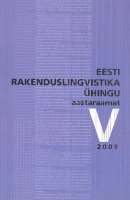Sõnavara loomulik rikkus haritud keeleoskaja tekstides
Natural lexical richness in educated language use
Author(s): Pilvi Alp, Hille Pajupuu, Krista KergeSubject(s): Language and Literature Studies
Published by: Eesti Rakenduslingvistika Ühing (ERÜ)
Keywords: L1; L2 acquisition; C1; lexical richness; vocabulary range; frequent words; text type; Uber index; Estonian
Summary/Abstract: Lexical richness/diversity and vocabulary range belong to measures of language competence. The vocabulary of local Russians with advanced Estonian proficiency (B2+/C1) was compared to the vocabulary of native Estonians with non-philological tertiary education. Three types of texts were used: oral dialogue, oral presentation and written essay. Lexical richness was measured by the Uber index. The vocabulary range was found by comparing the L1 and L2 vocabularies used by the subjects to a list of 10,000 most frequent words. The two groups differed considerably on lexical richness: L1 results surpassed those of L2 in dialogue as well as in monologue, but most of all in essay. Vocabulary range, however, showed a similar pattern for the two groups: 65% of the L1 vocabulary used and 70% of that of L2 belonged, both in oral and written use, to the basic vocabulary, i.e. to the first 3000 words on the frequency list. The proportion of rare words (range over 10.000) was about 20%, in oral as well as written texts in both L1 and L2. Considering the above results together with the indices of text formality, which were rather similar for L1 and L2, we reached the conclusion that poorer vocabulary is no real hindrance to either free talking or writing, if the word use is adequate to register and genre.
Journal: Eesti Rakenduslingvistika Ühingu aastaraamat
- Issue Year: 2009
- Issue No: 5
- Page Range: 187-196
- Page Count: 10
- Language: Estonian

